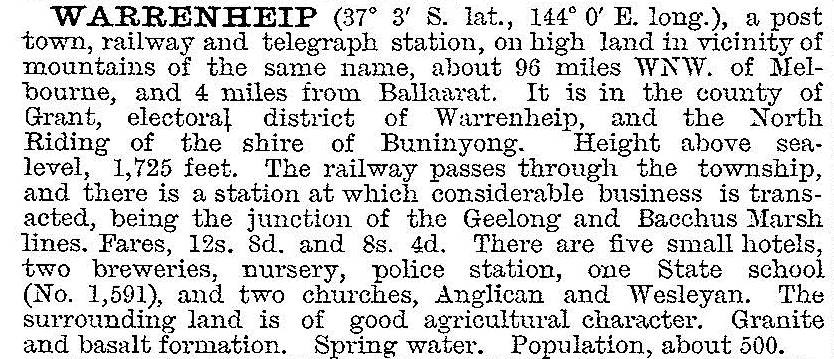Warrenheip
Warrenheip is a rural township about 2 km beyond the eastern outskirt of Ballarat. It is at the junction of the railway lines from Geelong (1862) and from Melbourne (1879) to Ballarat. It is thought that the name is derived from an Aboriginal word meaning trees on a mountain top or emu feathers on top. Mount Warrenheip is 2 km west of the centre of Warrenheip, and is in a State Forest.
Warrenheip is towards the western end of an area of rich volcanic soil which was occupied by many Irish-Catholic families who took up 20-acre farms. The land was good for growing vegetables, particularly potatoes. A Catholic school was opened in 1862. Being adjacent to the goldfields which were worked by Cornish and Welsh miners, two Wesleyan schools were also opened at Warrenheip a few years before. All three schools closed in the mid-1870s when a government school was opened. The Catholic population, however, had a school at Dunnstown, about 5 km distant, where Our Lady of Fatima school continues.
The district was prominent in the liquor business: distillery at Dunnstown and a brewery at Warrenheip (1887-1922). Bailliere’s Victorian gazetteer recorded eight hotels in the area (1865). Warrenheip was described in the Australian handbook in 1903:

(The absence of a Catholic church suggests the importance of the church in Dunnstown.)
At the base of Mount Warrenheip the Kryal Castle (medieval displays) has been opened. Historically more authentic, there is the ‘Killarney’ mansion (1895), Dunnstown Road, on the Register of the National Estate. The imposing railway station near the junction of the two lines has been demolished.
Warrenheip has a general store, a public reserve, a church, a hall and a State school (40 pupils, 2014). Woodmans Hill motel is just inside the western edge of Warrenheip.
Its census populations have been:
| Area | Census date | Population |
|---|---|---|
| Warrenheip | 1871 | 326 |
| 1911 | 411 | |
| 1933 | 324 | |
| 1966 | 283 | |
| Warrenheip and environs | 2006 | 435 |
| 2011 | 597 |
Further Reading
Peter M. Griffiths, Three times blest: a history of Buninyong and district 1837-1901, Buninyong, 1988


